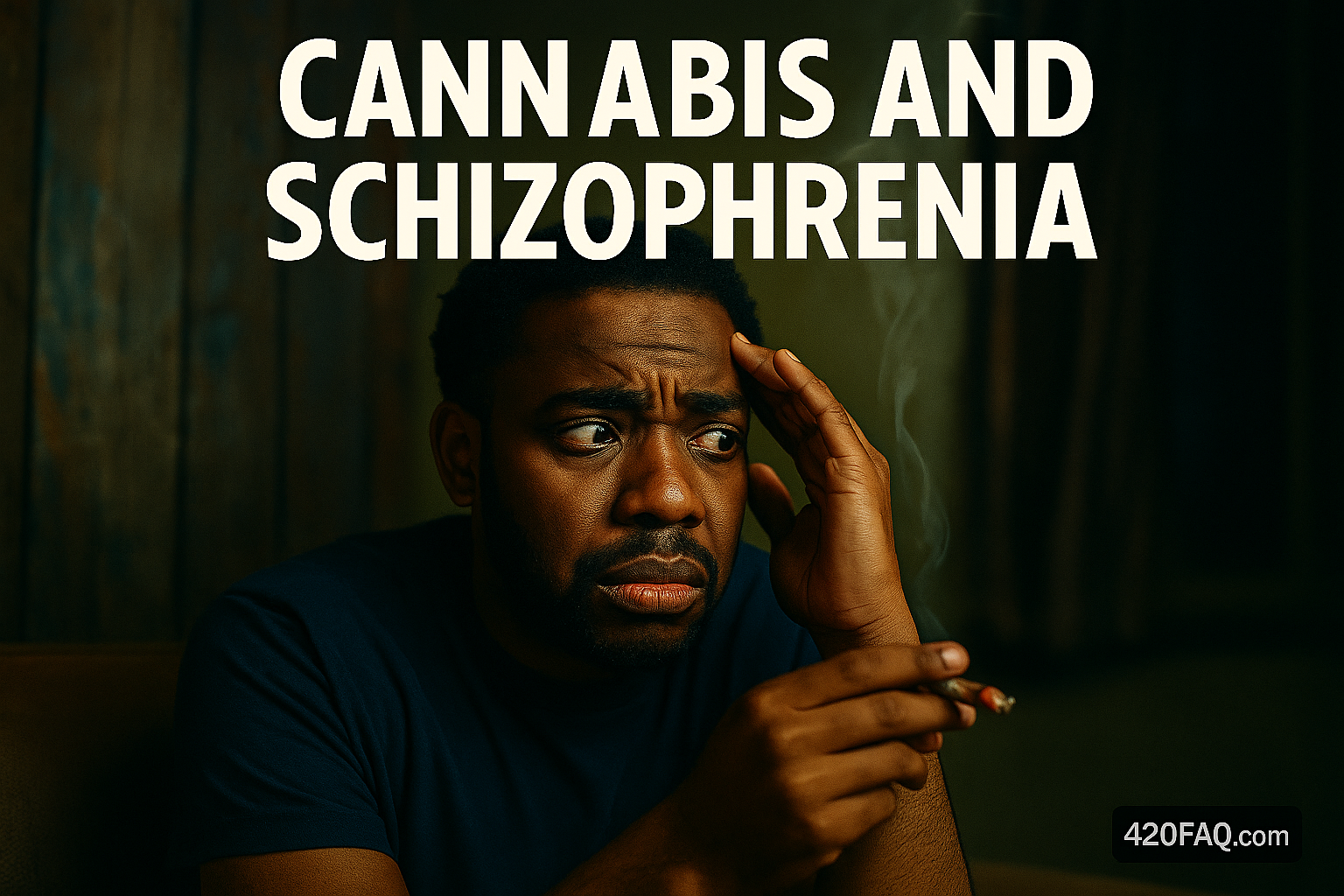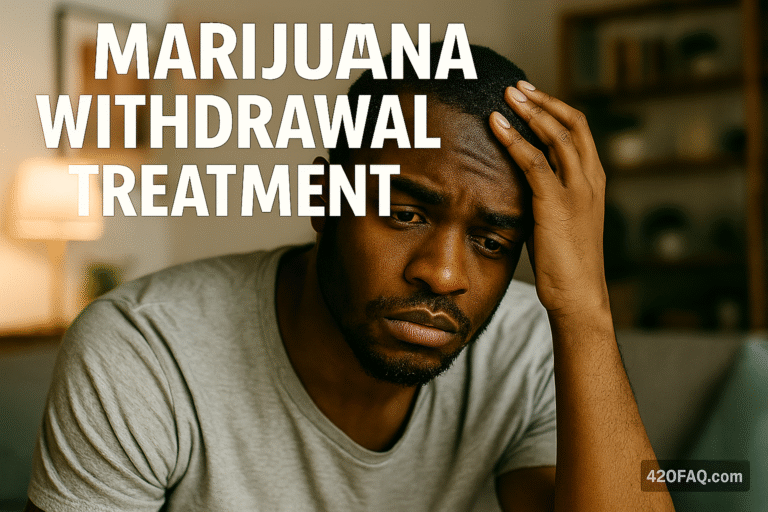
Cannabis and Schizophrenia: Comprehensive Guide to Understanding the Connection and Risks
Understanding the relationship between cannabis use and schizophrenia represents crucial knowledge for individuals, families, healthcare providers, and policymakers navigating the complex intersection of marijuana consumption and serious mental illness. The connection between cannabis and schizophrenia involves intricate neurobiological mechanisms, genetic vulnerabilities, developmental timing factors, and dose-response relationships that have been extensively studied yet remain subjects of ongoing research and debate. Comprehending how cannabis may trigger, accelerate, or worsen schizophrenia symptoms, which populations face elevated risks, and what protective strategies exist empowers individuals to make informed decisions about cannabis use while recognizing early warning signs requiring professional intervention.
Understanding Schizophrenia Fundamentals
Cannabis and schizophrenia connection fundamentals begin with understanding what schizophrenia is, how it develops, its symptoms and course, and the neurobiological underpinnings that may interact with cannabinoid exposure through various mechanisms.
Schizophrenia represents a severe, chronic mental disorder affecting approximately 1% of the global population, characterized by distortions in thinking, perception, emotions, language, sense of self, and behavior. This complex psychiatric condition typically emerges in late adolescence or early adulthood, with males often experiencing earlier onset than females. The disorder profoundly impacts functioning across social, occupational, and personal domains, requiring long-term management and substantially affecting quality of life for patients and families.
The symptom profile of schizophrenia encompasses positive symptoms (hallucinations, delusions, disorganized thinking and speech, abnormal motor behavior), negative symptoms (reduced emotional expression, decreased motivation, social withdrawal, diminished speech), and cognitive symptoms (impaired attention, memory problems, executive function deficits). These symptoms vary in severity and combination across individuals, creating heterogeneous presentations that complicate diagnosis and treatment.
Neurobiological factors underlying schizophrenia involve dysregulation of neurotransmitter systems (particularly dopamine and glutamate), structural brain abnormalities (reduced gray matter volume, enlarged ventricles, altered connectivity), and disrupted neural development during critical periods. These biological abnormalities interact with genetic vulnerabilities and environmental factors to produce the clinical syndrome, with cannabis representing one environmental factor that may influence disease onset, progression, and severity.
The prevalence of schizophrenia remains relatively stable across cultures and populations at approximately 0.7-1.0%, though onset patterns, symptom presentations, and outcomes vary based on genetic background, environmental exposures, access to treatment, and social support systems. Understanding baseline schizophrenia risk helps contextualize the additional risk associated with cannabis use.
The Cannabis-Schizophrenia Association
The relationship between cannabis use and schizophrenia has been documented through decades of research demonstrating consistent associations between marijuana consumption and increased risk of developing schizophrenia and related psychotic disorders, though causation complexity requires careful interpretation.
Epidemiological evidence consistently shows that cannabis users experience higher rates of schizophrenia compared to non-users across multiple large-scale longitudinal studies conducted in different countries. Meta-analyses indicate that cannabis use approximately doubles the risk of developing schizophrenia or other psychotic disorders, with dose-response relationships showing higher consumption associated with greater risk elevation. These associations persist after controlling for confounding variables like other substance use, socioeconomic factors, and pre-existing mental health conditions.
Temporal relationships support cannabis as a potential causal factor, with marijuana use typically preceding schizophrenia onset rather than following it. Prospective studies tracking individuals over time demonstrate that cannabis use during adolescence and early adulthood predicts later schizophrenia development, even after accounting for prodromal symptoms that might precede both cannabis use and full psychotic illness. This temporal sequence strengthens causal inference beyond simple correlation.
Dose-response relationships show that heavier, more frequent, and longer-duration cannabis use correlates with progressively higher schizophrenia risk. Studies demonstrate that daily users face substantially elevated risk compared to occasional users, and individuals who begin using cannabis heavily during adolescence show the strongest associations. High-potency cannabis products with elevated THC content appear particularly problematic, with some research suggesting stronger associations between potent marijuana and psychosis risk.
Biological plausibility supports the cannabis-schizophrenia connection through multiple mechanisms. THC (tetrahydrocannabinol) affects brain systems implicated in schizophrenia, including dopamine pathways, glutamate signaling, and endocannabinoid regulation. Cannabis exposure during critical neurodevelopmental periods may disrupt normal brain maturation processes, potentially contributing to structural and functional abnormalities observed in schizophrenia. These biological pathways provide mechanistic explanations for observed epidemiological associations.
Mechanisms Linking Cannabis to Schizophrenia
Understanding how cannabis may contribute to schizophrenia development requires examining the neurobiological mechanisms through which cannabinoids affect brain systems implicated in psychotic disorders, including neurotransmitter dysregulation, neurodevelopmental disruption, and genetic vulnerabilities.
Dopamine system dysregulation represents a primary mechanism linking cannabis to schizophrenia, as THC increases dopamine release in brain regions associated with psychotic symptoms. The dopamine hypothesis of schizophrenia posits that excessive dopamine activity in mesolimbic pathways contributes to positive symptoms like hallucinations and delusions. Cannabis acutely increases dopamine transmission, and chronic use may produce lasting changes in dopamine system function, potentially triggering or exacerbating psychotic symptoms in vulnerable individuals.
Glutamate system disruption provides another mechanistic pathway, as cannabis affects glutamatergic neurotransmission through complex interactions with NMDA receptors and other glutamate signaling components. The glutamate hypothesis of schizophrenia suggests that NMDA receptor hypofunction contributes to both positive and negative symptoms. THC’s effects on glutamate systems may disrupt the delicate balance of excitatory neurotransmission required for normal cognition and perception, potentially contributing to psychotic symptoms.
Endocannabinoid system alterations occur with chronic cannabis exposure, as exogenous cannabinoids from marijuana overwhelm the brain’s natural endocannabinoid signaling. The endocannabinoid system regulates neurotransmitter release, synaptic plasticity, and neural development. Disrupting this system through heavy cannabis use may impair normal brain function and maturation, particularly during adolescence when neural circuits are still developing. Some research suggests endocannabinoid system abnormalities in schizophrenia patients, potentially representing a vulnerability factor that cannabis exposure exacerbates.
Neurodevelopmental disruption during critical periods represents a particularly concerning mechanism, as adolescent brain development involves extensive remodeling of neural circuits, synaptic pruning, and myelination. Cannabis exposure during these sensitive periods may interfere with normal developmental processes, leading to lasting structural and functional brain abnormalities. Animal studies demonstrate that adolescent cannabinoid exposure produces different effects than adult exposure, supporting the concept of developmental vulnerability windows.
Risk Factors and Vulnerable Populations
Not all cannabis users develop schizophrenia, indicating that individual vulnerability factors determine who experiences psychotic outcomes following marijuana exposure. Understanding these risk factors helps identify populations requiring particular caution regarding cannabis use.
Genetic vulnerability represents the strongest predictor of schizophrenia risk following cannabis exposure. Individuals with family histories of schizophrenia or other psychotic disorders face substantially elevated risk when using cannabis compared to those without genetic loading. Specific genetic variants, particularly in genes involved in dopamine metabolism (like COMT) and endocannabinoid signaling, appear to moderate cannabis-psychosis associations. The interaction between genetic predisposition and environmental exposure (gene-environment interaction) explains why some cannabis users develop schizophrenia while most do not.
Age of first use critically influences schizophrenia risk, with adolescent cannabis initiation associated with significantly higher risk compared to adult-onset use. Research consistently demonstrates that individuals beginning regular cannabis use before age 15-16 face greater schizophrenia risk than those starting in their twenties or later. This age-dependent vulnerability likely reflects ongoing neurodevelopmental processes during adolescence that cannabis exposure disrupts, creating lasting consequences for brain structure and function.
Male gender represents a demographic risk factor, as Heavy Cannabis Use Linked to Schizophrenia, Especially among Young Men according to epidemiological research. Males show earlier schizophrenia onset than females on average and appear particularly vulnerable to cannabis-related psychosis risk. Some studies suggest stronger cannabis-schizophrenia associations in males, possibly reflecting sex differences in endocannabinoid system function, hormonal influences, or patterns of cannabis consumption.
Personal history of psychotic symptoms, even transient or mild experiences, indicates elevated vulnerability to cannabis-induced psychosis and schizophrenia. Individuals who have experienced brief psychotic episodes, unusual perceptual experiences, or paranoid thoughts when using cannabis or in other contexts face higher risk of developing full schizophrenia syndrome. These symptoms may represent prodromal features of emerging psychotic illness that cannabis exposure accelerates or precipitates.
Cannabis-Induced Psychosis
Cannabis can trigger acute psychotic episodes even in individuals without established schizophrenia, representing a distinct but related phenomenon that may serve as a pathway to chronic psychotic disorders in vulnerable individuals.
Acute cannabis-induced psychosis manifests as temporary psychotic symptoms occurring during or shortly after cannabis intoxication, including hallucinations (typically auditory but sometimes visual), paranoid delusions, confused thinking, and disorganized behavior. These episodes typically resolve within hours to days as THC clears from the system, distinguishing acute cannabis-induced psychosis from schizophrenia’s persistent symptoms. However, some individuals experience prolonged psychotic episodes lasting weeks, blurring the distinction between substance-induced and primary psychotic disorders.
Risk factors for cannabis-induced psychosis include high-dose consumption, use of high-potency cannabis products, synthetic cannabinoids, personal or family history of psychosis, underlying vulnerability factors, and co-use with other substances. First-time users or individuals with limited cannabis experience may be particularly susceptible to acute psychotic reactions, especially when consuming potent products without understanding their strength or appropriate dosing.
The relationship between acute cannabis psychosis and schizophrenia development remains an active research area, with evidence suggesting that individuals experiencing cannabis-induced psychotic episodes face substantially elevated risk of later developing schizophrenia. Longitudinal studies show that many people diagnosed with schizophrenia had prior cannabis-induced psychotic episodes, suggesting these acute reactions may represent early manifestations of underlying vulnerability rather than isolated substance effects. The transition rate from cannabis-induced psychosis to schizophrenia varies across studies but appears substantial, particularly among those with other risk factors.
Management of acute cannabis-induced psychosis typically involves supportive care in safe environments, benzodiazepines for severe agitation, and occasionally antipsychotic medications for persistent or severe symptoms. Most episodes resolve without intervention as THC metabolism proceeds, though medical evaluation is warranted to rule out other causes and assess ongoing risk. Individuals experiencing cannabis-induced psychosis should be counseled about their elevated schizophrenia risk and strongly advised to abstain from future cannabis use.
Impact on Schizophrenia Course and Outcomes
Beyond potentially triggering schizophrenia onset, cannabis use affects disease course and outcomes in individuals with established psychotic disorders, generally worsening symptoms, functioning, and treatment response across multiple domains.
Symptom exacerbation occurs consistently with cannabis use in schizophrenia patients, with marijuana consumption associated with increased positive symptoms (hallucinations, delusions), cognitive impairment, and disorganization. Studies demonstrate that schizophrenia patients who use cannabis experience more severe and frequent psychotic symptoms compared to abstinent patients. Even occasional cannabis use can trigger symptom relapses in otherwise stable patients, complicating treatment and recovery efforts.
Earlier onset of schizophrenia is associated with cannabis use, with marijuana users typically developing first-episode psychosis 2-3 years earlier than non-users on average. This earlier onset has significant implications, as younger age at illness onset generally predicts worse long-term outcomes. The acceleration of illness onset may reflect cannabis triggering psychosis in genetically vulnerable individuals who might have developed schizophrenia later or potentially not at all without cannabis exposure.
Treatment resistance appears more common among cannabis-using schizophrenia patients, with marijuana consumption interfering with antipsychotic medication effectiveness. Studies show that patients who continue cannabis use during treatment show poorer response to antipsychotic medications and require higher doses to achieve symptom control. The mechanisms underlying this interference may involve cannabis effects on the same neurotransmitter systems that antipsychotics target, creating a pharmacological antagonism that reduces medication efficacy.
Functional outcomes including social relationships, employment, independent living, and overall quality of life are consistently worse in schizophrenia patients who use cannabis compared to abstinent patients. Cannabis use predicts poorer social functioning, more frequent hospitalizations, higher rates of homelessness, increased involvement with criminal justice systems, and reduced quality of life across multiple studies. These negative functional impacts persist even after controlling for symptom severity and other substance use.
High-Potency Cannabis and Increased Risk
The evolving cannabis market increasingly features high-potency products with dramatically elevated THC concentrations compared to historical marijuana, raising particular concerns about schizophrenia risk as potency-related effects appear dose-dependent.
THC potency increases in commercial cannabis products have been substantial over recent decades, with average THC concentrations rising from 3-4% in 1990s marijuana to 15-20% in current flower products and even higher levels (60-90%+) in concentrates, oils, and extracts. This dramatic potency increase means that contemporary cannabis users consume far higher THC doses per use occasion than historical users, potentially explaining some observed increases in cannabis-related harms including psychosis.
Research on high-potency cannabis demonstrates stronger associations with psychotic disorders compared to lower-potency products. Studies from Europe comparing different cannabis types found that daily use of high-potency cannabis (>10% THC) was associated with a five-fold increase in psychosis risk compared to never users, substantially higher than the risk elevation from lower-potency products. A notable video discussing the link between cannabis and psychosis explores these potency-related concerns in detail.
Mechanisms explaining potency-related risk likely involve dose-dependent effects on neurotransmitter systems, with higher THC doses producing greater dopamine release, more profound disruption of glutamate signaling, and stronger interference with normal brain function. Additionally, high-potency products often contain minimal CBD (cannabidiol), which may have protective properties against THC’s psychotomimetic effects. The absence of CBD in concentrate products may remove a natural moderating factor, amplifying psychosis risk.
Concentrates and extracts including wax, shatter, oils, and dabs represent the most potent cannabis products with THC concentrations reaching 60-90%. These products deliver massive THC doses in single use occasions, producing intense intoxication that may overwhelm normal brain function and trigger acute psychotic reactions even in individuals without prior vulnerability. The relatively recent widespread availability of these ultra-high-potency products raises concerns about population-level impacts on psychosis rates.
Protective Factors and CBD
While THC appears to increase schizophrenia risk, other cannabis components and various protective factors may moderate these risks or provide potential therapeutic benefits, suggesting nuanced relationships between different cannabinoids and psychotic disorders.
Cannabidiol (CBD) represents a non-intoxicating cannabis compound with potentially antipsychotic properties demonstrated in preclinical and preliminary clinical research. CBD appears to have opposite effects from THC on several brain systems relevant to psychosis, potentially counteracting some of THC’s harmful effects. Studies suggest CBD may reduce anxiety, have neuroprotective properties, and possibly provide antipsychotic benefits, though research remains preliminary and clinical applications uncertain.
CBD-to-THC ratios in cannabis products may influence psychosis risk, with high-THC/low-CBD products appearing most problematic. Historical cannabis varieties contained more balanced cannabinoid profiles with significant CBD content, while modern selective breeding has maximized THC while minimizing CBD. Some evidence suggests that products with higher CBD ratios relative to THC may carry lower psychosis risk, though research in this area remains limited and definitive conclusions premature.
Genetic protective factors may exist alongside vulnerability factors, with some gene variants potentially conferring resilience against cannabis-related psychosis risk. Understanding protective genetic factors could help identify individuals at lower risk and inform personalized guidance about cannabis use, though such genetic testing remains unavailable for clinical use currently.
Social and environmental protective factors including strong family support, absence of childhood trauma, good general health, stable living situations, and absence of other substance use may reduce schizophrenia risk generally and potentially moderate cannabis-related risk specifically. While these factors cannot eliminate risk in highly vulnerable individuals, they may provide some protection for those with moderate vulnerability.
Adolescent Brain Development and Cannabis
The adolescent period represents a time of particular vulnerability to cannabis effects on schizophrenia risk, as ongoing neurodevelopmental processes during this critical window may be disrupted by cannabinoid exposure with lasting consequences.
Neurodevelopmental processes during adolescence include synaptic pruning (elimination of unnecessary neural connections), myelination (insulation of nerve fibers for faster transmission), maturation of prefrontal cortex (executive functions, decision-making, impulse control), and refinement of dopamine systems. These processes are essential for developing adult brain function and appear particularly vulnerable to disruption by exogenous cannabinoids during this sensitive period.
Critical periods for brain development correspond to times of heightened vulnerability to environmental insults, with adolescence representing such a critical period for circuits involved in higher cognition, emotion regulation, and reality testing. Cannabis exposure during these windows may produce lasting alterations to brain structure and function that persist into adulthood, potentially setting the stage for later psychiatric disorders including schizophrenia.
Animal research demonstrates that adolescent cannabinoid exposure produces different and more severe effects than adult exposure, including lasting changes to dopamine function, altered brain structure, cognitive impairments, and increased behaviors analogous to psychotic symptoms. These animal studies provide mechanistic insights into how adolescent cannabis use may increase schizophrenia risk through developmental disruption.
Epidemiological evidence consistently demonstrates stronger cannabis-schizophrenia associations for adolescent-onset use compared to adult-onset use, with early initiation (before age 15-16) associated with substantially higher risk than later initiation. Each year of delayed initiation during adolescence appears to reduce risk, supporting recommendations to delay any cannabis use until the brain has completed major developmental processes in the mid-twenties.
Differential Diagnosis and Clinical Presentation
Distinguishing between cannabis-induced psychosis, schizophrenia emerging in a cannabis user, and primary schizophrenia unrelated to cannabis represents a significant clinical challenge with important implications for treatment and prognosis.
Diagnostic challenges arise because cannabis-induced psychosis and schizophrenia share many symptoms, cannabis use is common in young adults (the typical age for schizophrenia onset), and individuals with emerging schizophrenia may use cannabis to self-medicate prodromal symptoms. Determining whether psychotic symptoms represent temporary drug effects or an emerging chronic disorder requires careful evaluation, longitudinal observation, and sometimes a period of abstinence to clarify the picture.
Temporal patterns help distinguish these conditions, with cannabis-induced psychosis typically occurring during or shortly after use and resolving relatively quickly with abstinence, while schizophrenia symptoms persist beyond acute intoxication periods. However, some cannabis-induced episodes are prolonged, and schizophrenia symptoms may fluctuate, complicating this distinction. Extended observation during abstinence (weeks to months) may be necessary for definitive diagnosis.
Symptom characteristics show some differences, with cannabis-induced psychosis more likely to involve visual hallucinations, paranoid themes, and confusion, while schizophrenia often includes auditory hallucinations, more bizarre delusions, and negative symptoms. However, these distinctions are not absolute, and considerable overlap exists in clinical presentations.
Treatment response provides diagnostic information, as cannabis-induced psychosis typically resolves quickly with abstinence and supportive care, while schizophrenia requires ongoing antipsychotic medication and comprehensive treatment. If symptoms persist despite prolonged abstinence or rapidly recur with minimal triggers, a diagnosis of primary schizophrenia becomes more likely.
Treatment Considerations
Managing schizophrenia in individuals with cannabis use histories or ongoing marijuana consumption requires integrated approaches addressing both the psychotic disorder and substance use, as continued cannabis consumption undermines treatment effectiveness and worsens outcomes.
Abstinence from cannabis represents a critical treatment component for anyone with schizophrenia or at high risk for psychotic disorders. Complete cessation allows clearer assessment of baseline symptoms, enables antipsychotic medications to work optimally, reduces risk of relapse and symptom exacerbation, and improves overall functional outcomes. Healthcare providers should strongly recommend cannabis abstinence for all patients with psychotic disorders.
Integrated treatment approaches combining mental health care and substance use treatment show better outcomes than parallel or sequential treatment models. Programs offering coordinated services for both schizophrenia and cannabis use disorder, ideally from the same clinical team, help patients address both conditions simultaneously and improve engagement and outcomes.
Motivational enhancement strategies help patients with ambivalence about reducing cannabis use recognize the connection between marijuana and their symptoms, understand personal consequences of continued use, and develop motivation for change. Many individuals with schizophrenia do not perceive their cannabis use as problematic or connected to their symptoms, making motivational approaches essential.
Cognitive-behavioral interventions specifically targeting cannabis use in psychosis populations help patients develop skills for refusing use, managing cravings, identifying triggers, and preventing relapse. These psychological interventions complement medication management and improve outcomes when implemented by clinicians with expertise in both psychosis and substance use.
Prevention and Harm Reduction
Given the established cannabis-schizophrenia connection, prevention efforts targeting vulnerable populations and harm reduction strategies for those who use cannabis despite risks represent important public health approaches.
Primary prevention focuses on preventing cannabis use initiation, particularly among adolescents and individuals with family histories of psychosis. Education about mental health risks should be incorporated into drug prevention programming, emphasizing that marijuana is not harmless and carries significant risks for vulnerable individuals. Delaying initiation until adulthood, if use occurs at all, reduces risk substantially.
Screening and early intervention for individuals at high risk based on family history, emerging symptoms, or early cannabis-induced psychotic reactions can facilitate early treatment and potentially prevent progression to full schizophrenia. Mental health professionals should routinely assess cannabis use and psychosis risk factors, providing targeted interventions for high-risk individuals.
Harm reduction for those who continue cannabis use despite risks includes recommendations to avoid high-potency products, minimize frequency and quantity of use, never use synthetic cannabinoids, avoid use during intoxication from other substances, and discontinue use immediately if psychotic symptoms emerge. While abstinence represents the safest approach for vulnerable individuals, harm reduction acknowledges that some will continue use and attempts to minimize associated risks.
Public education about cannabis-psychosis risks remains important as marijuana legalization expands and public perception of cannabis as harmless increases. Balanced, evidence-based information about mental health risks, particularly for adolescents and vulnerable populations, should be widely disseminated through schools, healthcare settings, media campaigns, and cannabis retail environments where legal.
The Causation Debate
Despite substantial evidence linking cannabis use to schizophrenia, debates continue about whether this relationship is truly causal or reflects confounding factors, reverse causation, or shared vulnerabilities, with important implications for policy and clinical practice.
Arguments for causation cite consistent epidemiological associations, temporal relationships showing cannabis use preceding schizophrenia onset, dose-response relationships, biological plausibility through multiple mechanisms, and evidence that reducing cannabis use in high-risk populations might prevent some schizophrenia cases. Bradford Hill criteria for establishing causation are largely satisfied by cannabis-schizophrenia research, supporting causal interpretation.
Alternative explanations proposed include reverse causation (individuals with emerging schizophrenia self-medicate with cannabis), shared genetic or environmental vulnerability factors (genes or experiences predisposing to both cannabis use and schizophrenia), confounding by other substance use or risk factors not adequately controlled in observational studies. These explanations could account for observed associations without cannabis directly causing schizophrenia.
Shared vulnerability models suggest that cannabis use and schizophrenia may share common underlying factors including genetic variants affecting dopamine function, early life adversity, impulsivity or novelty-seeking traits, and other psychological or biological characteristics. Under this model, cannabis doesn’t cause schizophrenia but individuals vulnerable to both outcomes are more likely to both use cannabis and develop psychosis.
Component cause framework provides a useful conceptual model, viewing cannabis as a component cause that contributes to schizophrenia development in individuals with other necessary vulnerability factors. Under this model, cannabis alone is neither necessary nor sufficient for schizophrenia (most users don’t develop psychosis, and most schizophrenia patients have other risk factors), but it represents one contributing factor that, in combination with genetic vulnerability, developmental disruptions, and other environmental stressors, produces the sufficient cause constellation leading to illness.
Policy and Legal Implications
The cannabis-schizophrenia relationship has important implications for marijuana policy debates, with considerations about legalization, regulation, public health messaging, and balancing individual liberty against population-level harms.
Legalization considerations must weigh documented mental health risks against arguments for personal freedom, criminal justice reform, and regulated markets. Evidence of schizophrenia risk doesn’t necessarily argue against legalization per se, but supports regulated approaches that protect vulnerable populations, restrict youth access, limit product potency, and fund prevention and treatment services.
Age restrictions represent a critical policy component given evidence that adolescent cannabis use carries substantially higher schizophrenia risk than adult use. Most legalization frameworks establish 21+ age limits, though enforcement challenges remain. Some experts advocate for even higher age limits (25+) given neurodevelopmental vulnerability extending into the mid-twenties.
Potency regulations could potentially reduce psychosis risk at population levels by limiting THC concentrations in commercial products, though such regulations remain rare and controversial. Some jurisdictions have considered or implemented THC limits, while others favor warning labels on high-potency products. The balance between restricting consumer choice and protecting public health continues to be debated.
Warning labels and public education requirements in legalized cannabis markets should include mental health risk information, particularly highlighting adolescent vulnerability and psychosis risks. Clear, evidence-based warnings similar to those on tobacco or alcohol products could help consumers make informed decisions, though effectiveness of warning labels in changing behavior remains uncertain.
Research Gaps and Future Directions
Despite extensive research on cannabis and schizophrenia, important questions remain unanswered, with ongoing studies investigating mechanisms, identifying vulnerable populations, developing prevention strategies, and exploring potential therapeutic applications of specific cannabinoids.
Causality clarification through natural experiments (comparing jurisdictions before/after legalization), advanced genetic studies examining gene-environment interactions, and experimental studies in animal models continues refining understanding of whether and how cannabis causes schizophrenia. Definitive human experimental studies remain ethically impossible, limiting causal inference to observational data and animal research.
Biomarker identification could enable prediction of who faces highest risk from cannabis use, potentially through genetic testing, neuroimaging, cognitive assessments, or other measures identifying vulnerability. Such biomarkers could inform personalized guidance about cannabis use and enable targeted prevention efforts for highest-risk individuals.
CBD therapeutic research is exploring whether cannabidiol may have antipsychotic properties useful for treating schizophrenia or preventing transition to psychosis in high-risk individuals. Several clinical trials are investigating CBD as an adjunct to antipsychotic medications or as a preventive intervention for at-risk youth, with preliminary results suggesting potential benefits requiring further study.
Long-term outcome studies tracking individuals from adolescence through schizophrenia risk periods while carefully measuring cannabis exposure, genetic factors, and other variables will further clarify relationships and enable more precise risk estimation. Longitudinal research over decades is necessary to fully understand how adolescent cannabis use affects lifetime schizophrenia risk.
Frequently Asked Questions About Cannabis and Schizophrenia
Can cannabis cause schizophrenia?
Research strongly suggests that cannabis use can contribute to schizophrenia development in vulnerable individuals, though the relationship is complex. Cannabis approximately doubles schizophrenia risk overall, with higher risks for heavy users, adolescent-onset users, and those with genetic vulnerability. Cannabis likely acts as a component cause—it doesn’t cause schizophrenia in everyone, and not all schizophrenia involves cannabis, but marijuana use increases risk substantially in those with underlying vulnerability. Evidence supporting a causal role includes consistent epidemiological associations, temporal relationships showing cannabis preceding psychosis onset, dose-response relationships, and biological mechanisms explaining how THC affects brain systems involved in schizophrenia.
How much does cannabis increase schizophrenia risk?
Meta-analyses of multiple studies indicate that cannabis use approximately doubles schizophrenia risk on average, increasing lifetime risk from about 1% in the general population to roughly 2% in cannabis users. However, risk varies substantially based on usage patterns. Daily cannabis use, especially of high-potency products, may increase risk three to five-fold or more. Adolescent-onset use shows stronger associations than adult-onset use. Individuals with family histories of psychosis face much higher absolute risks when using cannabis. While these increases are statistically significant and clinically meaningful, they also mean that most cannabis users will not develop schizophrenia, reflecting the importance of individual vulnerability factors.
Who is most at risk for cannabis-induced psychosis?
Certain individuals face substantially elevated risk for cannabis-induced psychosis and schizophrenia. Highest-risk groups include: those with family histories of schizophrenia or psychotic disorders (genetic vulnerability), adolescents and young adults whose brains are still developing, males (who show earlier psychosis onset and stronger cannabis associations), individuals with prior psychotic symptoms or unusual experiences, carriers of specific genetic variants affecting dopamine metabolism, those using high-potency cannabis products or concentrates, and heavy/frequent users. Anyone experiencing psychotic symptoms with cannabis use should consider themselves high-risk and avoid future marijuana exposure. No definitive way exists to predict individual risk, making caution warranted for all potential users.
What is cannabis-induced psychosis?
Cannabis-induced psychosis refers to acute psychotic symptoms triggered by marijuana use, including hallucinations (usually auditory but sometimes visual), paranoid delusions, confused or disorganized thinking, and bizarre behavior. These episodes occur during or shortly after cannabis intoxication and typically resolve within hours to days as THC clears the system. However, some episodes persist longer, and individuals experiencing cannabis-induced psychosis face substantially elevated risk of later developing schizophrenia. Risk factors include high-dose exposure, potent products, personal or family psychosis history, and underlying vulnerability. Anyone experiencing psychotic symptoms with cannabis should seek medical evaluation and avoid future use given their elevated risk for chronic psychotic disorders.
Does cannabis make schizophrenia worse?
Yes, cannabis use consistently worsens outcomes in individuals with established schizophrenia across multiple domains. Marijuana consumption in schizophrenia patients is associated with more severe positive symptoms (hallucinations and delusions), increased cognitive impairment, more frequent relapses and hospitalizations, reduced antipsychotic medication effectiveness, poorer functional outcomes including social relationships and employment, increased substance use disorders, and worse overall quality of life. Even occasional cannabis use can trigger symptom relapses in otherwise stable patients. For these reasons, complete cannabis abstinence is strongly recommended for anyone with schizophrenia or related psychotic disorders. Healthcare providers should consistently advise patients about these risks and provide support for achieving and maintaining abstinence.
Are high-potency cannabis products more dangerous?
Yes, research indicates that high-potency cannabis products pose greater schizophrenia risk than lower-potency marijuana. Studies comparing different product types found that daily use of high-potency cannabis (>10% THC) was associated with approximately five-fold increased psychosis risk compared to never users, substantially higher than risks from lower-potency products. Modern cannabis products including concentrates, wax, shatter, and oils can contain 60-90% THC, delivering massive doses that may overwhelm normal brain function and trigger acute psychotic reactions. High-potency products also typically contain minimal CBD, which may provide some protection against THC’s psychotomimetic effects. The dramatic increases in cannabis potency over recent decades raise concerns about population-level impacts on psychosis rates, particularly among adolescents and young adults.
Can CBD help with schizophrenia?
Preliminary research suggests that CBD (cannabidiol) may have antipsychotic properties, though evidence remains early-stage and clinical applications uncertain. CBD appears to have opposite effects from THC on several brain systems relevant to psychosis and may counteract some harmful THC effects. Small clinical trials have shown some promise for CBD as an adjunct treatment to antipsychotic medications, with suggestions of symptom improvement and fewer side effects. Research is also exploring whether CBD might help prevent transition to psychosis in high-risk individuals. However, CBD should not be considered a proven treatment for schizophrenia, and patients should not substitute CBD for prescribed antipsychotic medications. Much more research is needed before clear clinical recommendations can be made about CBD use in psychotic disorders.
Does stopping cannabis use reverse schizophrenia risk?
Stopping cannabis use doesn’t eliminate schizophrenia risk in individuals who have already used marijuana, particularly if use occurred during vulnerable developmental periods or if genetic susceptibility exists. However, discontinuing use reduces ongoing risk and prevents further harm. For individuals experiencing early psychotic symptoms or cannabis-induced psychosis, immediate cessation may help prevent progression to full schizophrenia, though some will develop the disorder regardless given underlying vulnerability. In established schizophrenia patients, stopping cannabis significantly improves outcomes, reduces symptoms, and enhances treatment effectiveness. Earlier cessation is better—avoiding use entirely during adolescence provides maximum protection, but quitting at any point reduces ongoing risks and improves functioning for those with psychotic disorders.
Should people with family histories of schizophrenia avoid cannabis?
Yes, individuals with family histories of schizophrenia or psychotic disorders should strongly consider avoiding cannabis entirely. Family history indicates genetic vulnerability, and research shows that genetic risk factors interact with cannabis exposure to substantially elevate schizophrenia risk. While having affected relatives doesn’t guarantee someone will develop schizophrenia, it significantly increases baseline risk, and cannabis use further amplifies this risk. Given the severity of schizophrenia and its profound impacts on functioning and quality of life, the potential recreational benefits of cannabis do not justify the elevated risk for genetically vulnerable individuals. Those with family histories who choose to use cannabis despite recommendations should avoid adolescent initiation, minimize frequency and potency, and immediately discontinue use if any unusual perceptual or cognitive experiences occur.
What should I do if I experience psychotic symptoms with cannabis?
If you experience hallucinations, paranoid thoughts, confused thinking, or other psychotic symptoms during or after cannabis use, you should seek immediate medical evaluation, completely discontinue all cannabis use, and inform healthcare providers about the episode. Even if symptoms resolve quickly, experiencing cannabis-induced psychosis indicates significant vulnerability to more serious psychiatric problems including schizophrenia. Medical evaluation helps rule out other causes, assess your risk level, and determine whether monitoring or preventive treatment is needed. Never use cannabis again after such an episode, as repeated exposure substantially increases risk of developing chronic psychotic disorders. If symptoms persist beyond a few days, urgent psychiatric evaluation is essential. Inform family members about the episode so they can monitor for emerging symptoms. Consider that this experience may reflect underlying vulnerability requiring professional assessment even after symptoms resolve.
Conclusion
Understanding the relationship between cannabis and schizophrenia represents essential knowledge for individuals making decisions about marijuana use, families concerned about vulnerable members, healthcare providers treating psychotic disorders, and policymakers developing cannabis regulations. While the connection involves complex interactions between genetic vulnerability, developmental timing, usage patterns, and product potency, substantial evidence demonstrates that cannabis significantly increases schizophrenia risk in susceptible individuals.
The effectiveness of prevention efforts depends on recognizing that not all individuals face equal risk from cannabis use, with adolescents, those with family histories of psychosis, males, and users of high-potency products facing particularly elevated dangers. Targeted education, screening, and early intervention for high-risk populations can potentially prevent some schizophrenia cases while respecting that most cannabis users will not develop psychotic disorders.
Successful management of schizophrenia in individuals with cannabis use histories requires integrated treatment addressing both the psychotic disorder and substance use, with complete abstinence from marijuana representing a critical component of recovery. Healthcare systems must develop capacity to deliver coordinated mental health and substance use services while recognizing the unique challenges of treating comorbid conditions.
The future of cannabis-schizophrenia research continues evolving with improved understanding of mechanisms, identification of genetic vulnerabilities enabling personalized risk assessment, exploration of protective factors including CBD, and investigation of prevention strategies for high-risk populations. As individuals navigate decisions about cannabis use in an era of increasing legalization and availability, they should base choices on scientific evidence recognizing documented mental health risks, exercise particular caution during adolescence and with family psychosis histories, and seek professional help immediately if psychotic symptoms emerge.





